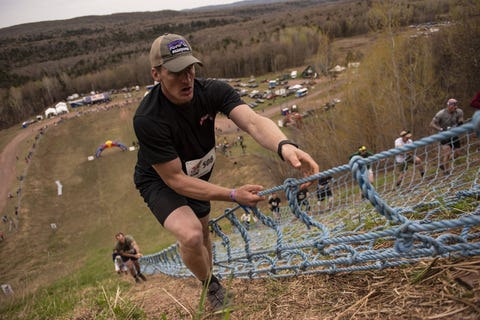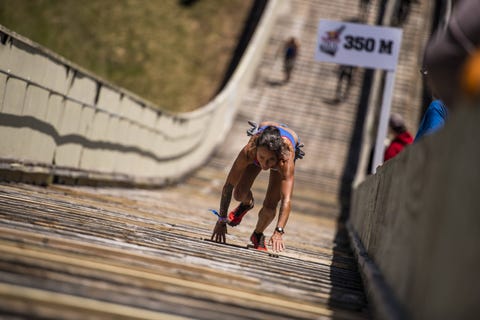The Red Bull 400 is a painful sprint, no matter if you’re an Army Ranger, Nordic skier, or magazine editor.

Sprouse and four other Rangers got their assignment only 48 hours ahead of the race, making the long trek to the farthest west region of Michigan’s Upper Peninsula from their base in Fort Benning, Georgia, to take on the most ridiculous quarter-mile sprint many will ever run.
Maybe that’s for the best, because even with months of advance notice, I learned you can’t truly prepare for the challenge that is “sprinting” more than 500 feet straight up into the sky.
Moments after finishing the race, Sprouse said it was one of the hardest things he’d ever done. Of course, that’s hyperbole coming from from a special operations soldier, trained to drop in on some of the hairiest situations around the globe. But, for the rest of us, the hurt ranks high on the list.
The Red Bull 400, in case you haven’t seen one of the insane promo videos for the race, is a 400-meter hill climb, ascending roughly 140 meters and finishing at the top of a ski jump. There are 17 races around the world.
The inaugural stop at Copper Peak in Ironwood, located along the Wisconsin border—or, as one racer said, “as far away from Michigan as you can get and still be in Michigan”—is one of three races held in North America (the others are Park City, Utah, and at Whistler Mountain in British Columbia, Canada). Why Ironwood? This tiny outpost boasts the only ski flying hill outside Europe. Ski flying is basically ski jumping, but at faster speeds and with longer flights. That also means the jumps are freaking tall and steep. In fact, Copper Peak is the steepest race on the tour.
Throughout the day of racing, there were 18 heats, each with 25 racers. The fastest 25 men and women both advanced to their own final races—yes, those lucky runners got to tackle the hill twice.
The race starts on flat ground, where the ski jumpers would come to a stop. From there, racers have only about 50 meters to spread out the field before hitting the hill. That’s also about the only running any of us did, because the grass where ski jumpers land is so steep and crumbly it’s a challenge just to walk up—most of us were already using our hands to hang onto the ground.
Red Bull laid down a rope netting to help racers claw their way up, but most of us used the edge of the net like a rope, going hand-over-hand to get up as fast as possible. (You can see the technique in this video.)
One of my goals entering the race was to “run” every step of the way. That shows how ill-prepared I was: Only 100 meters into the race, I was already clutching the rope. I probably should have prepared better by hitting the gym, too, because after 100 meters of rope climbing, my arms were toast. I hit the top of the grassy slope and could do little more than slump over and shuffle toward the wooden ski jump. I’d blasted up the hill as fast as I could, but the jump itself loomed over me, with the finish line barely recognizable somewhere up in the cloudless blue sky.
I’d like to say the jump was easier than the grass. But that’s a lie. At least the wooden structure had 2×2 boards nailed down across it, so we could use those like steps. And they were spaced apart just about the right distance for a 6-foot tall guy to power hike. It somehow went quickly, in retrospect, though I did not ascend it fast. For every 10 steps or so that I took, most with my hands on my knees, I’d stop for a few seconds to try to suck in some fresh air. Unfortunately, being hunched over and crawling closes off your air passages, so I was really doing little more than gasping.
With a camera in my face near the finish line, I pretended like I was running. Inside, I was dying. Or, at least, that’s how it felt. As soon as I stopped my watch, I had intense pain radiating from my upper chest and neck. I couldn’t tell whether I was going to have a heart attack or vomit—nor which I preferred at that moment. Having been a miler decades ago, I was prepared for that burning lung sensation and postrace cough, but that doesn’t make it hurt any less.
After the short walk back down the ski jump—my legs didn’t really cooperate, and I had to hang onto the guard rails so I didn’t snowball down the ramp—we all collected ourselves at the top of the hill and watched the next wave of runners. If you had nothing but audio to judge by, you’d have guessed we were all two-pack-a-day smokers, hacking up our lungs and wheezing.
My performance, a 6:38.8 to win the media heat, was good for fourth place overall at the time, but I slipped to 12th overall by the end of the day. That would have qualified me for the finals, though I stayed on the sidelines and watched the other competitors suffer up the hill a second time.
“The first time you felt it in your breath and heart rate,” said Matt Lipsey, who finished second overall in 5:01.4. “The second time you felt it in you legs—I didn’t get the blood taste.”
Will I race the Red Bull 400 again? For sure. It was an incredibly fun event. There were nearly 400 runners testing themselves against the mountain that day. And, despite the festival setup and a couple thousand spectators, the entire scene had a grass roots vibe; this certainly wasn’t your ordinary big city road race.
It’s uncertain whether the race will return to Ironwood next year, but even if it doesn’t, there’s always Whistler (July 14) or Park City (September 15).
But, before then, I need to hit the gym and work on my arms.
View the full article here.


